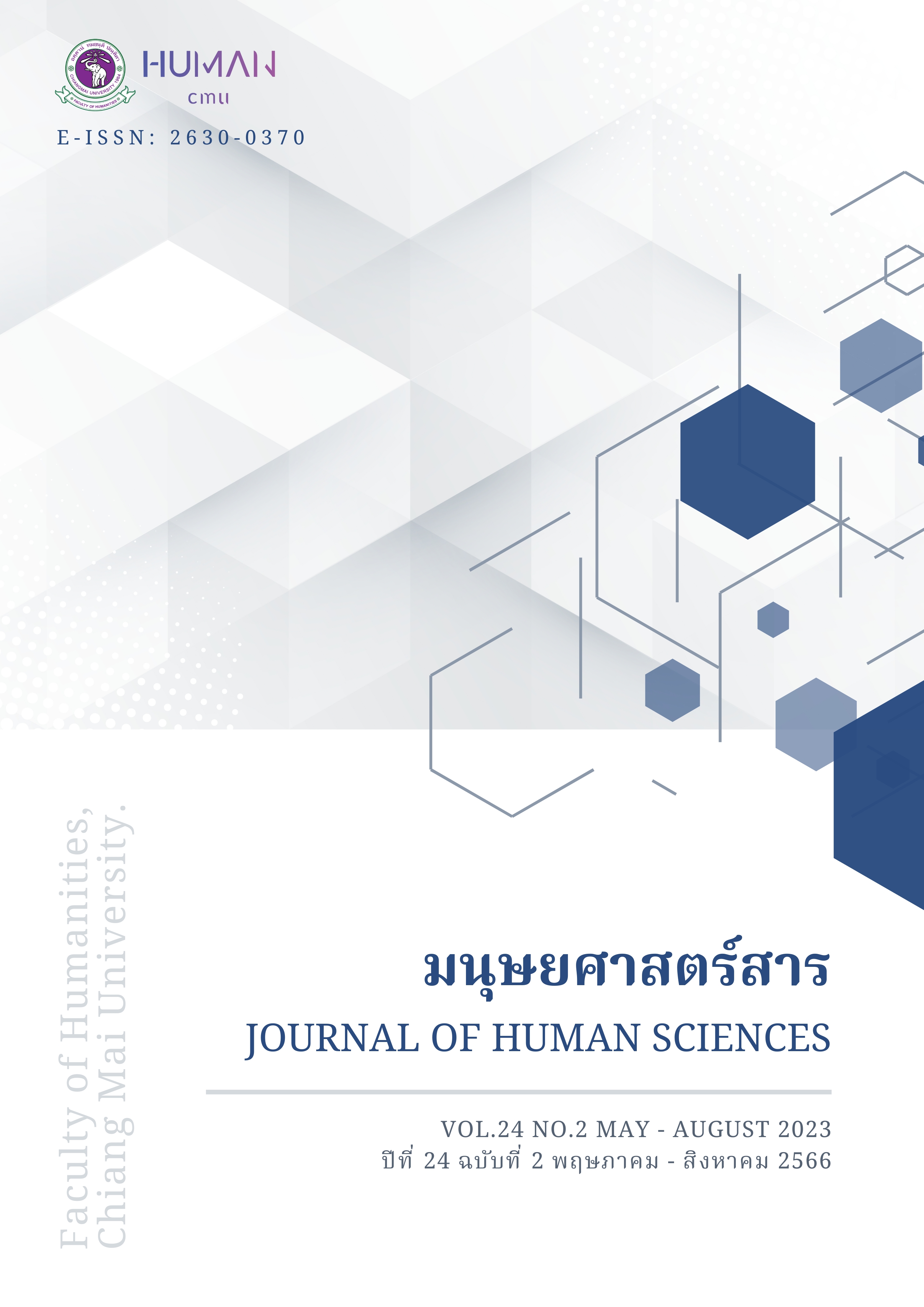Shall และคำแปลภาษาไทยในสนธิสัญญาภาษีซ้อนอาเซียน: การศึกษาโดยใช้คลังข้อมูลภาษา
Main Article Content
บทคัดย่อ
งานวิจัยนี้มีวัตถุประสงค์ที่จะแสดงให้เห็นถึงหน้าที่ของ shall และคำแปลภาษาไทยของ shall ในสนธิสัญญาภาษีซ้อนที่ไทยทำกับประเทศต่างๆในอาเซียน มีการศึกษาความสัมพันธ์ของคำว่า shall และคำแปลภาษาไทยทั้งในภาษาเดียวกันและระหว่างภาษา โดยใช้คลังข้อมูลภาษากฎหมายที่สร้างขึ้นเองจำนวน 3 คลัง ได้แก่ คลังข้อมูลเทียบภาษาอังกฤษ (228,280 คำ) คลังข้อมูลเทียบบทภาษาอังกฤษเป็นไทย (146,334 คำ) และคลังข้อมูลเทียบภาษาไทย (1,173,485 คำ) งานวิจัยนี้เริ่มจากการศึกษาความถี่และหน้าที่ของ shall ในสนธิสัญญาภาษีซ้อนในอาเซียนโดยอิงจากแนวคิดเรื่อง plain writing principles ของ Williams (2011) จากนั้นได้เปรียบเทียบ shall กับคำแปลภาษาไทยซึ่งอธิบายโดยใช้แนวคิดเรื่อง equivalence ของ Biel (2014) และ source language shining through ของ Teich (2003) อีกทั้งยังศึกษาความสัมพันธ์คำแปลภาษาไทยของ shall กับคำเดียวกันที่ปรากฎในคลังข้อมูลเทียบภาษาไทยว่ามีความแตกต่างกันหรือไม่โดยใช้กับแนวคิดเรื่อง textual fit ของ Biel (2014) และ normalization ของ Teich (2003) ผลการวิจัยแสดงให้เห็นว่า ทั้งผู้ร่างสนธิสัญญาภาษีซ้อนอาเซียนและนักแปลไม่ได้นำแนวคิดเรื่อง plain writing principles มาใช้กับคำว่า shall และมีหลักฐานแสดงให้เห็นถึง equivalence ของ Biel (2014) และ source language shining through ของ Teich (2003) ซึ่งแสดงว่าการแปลคำว่า shall ยึดตามลักษณะของภาษาต้นทางมากกว่า ส่งผลให้คำแปลที่ได้มีลักษณะแตกต่างจากการใช้คำเดียวกันในภาษาปลายทาง
Article Details

อนุญาตภายใต้เงื่อนไข Creative Commons Attribution-NonCommercial-NoDerivatives 4.0 International License.
เอกสารอ้างอิง
Adler, M. (2012). The plain language movement. In L. M. Solan & P. M. Tiersma (Eds.), The Oxford handbook of language and law (pp. 67-83). Oxford University Press.
Biel, Ł. (2014). Lost in the eurofog: The textual fit of translated law. Peter Lang.
Cambridge Dictionary (2023). https://dictionary.cambridge.org/
European Commission. (2022). English style guide of European Commission: A handbook for authors and translators in the European Commission. English Style Guide - European Commission / english-style-guide-european-commission.pdf / PDF4PRO
Felici, A. (2012). Shall ambiguities in EU legislative texts. Comparative Legilinguistics, 10(1), 51-66.
Foley, R. (2000). Legislative language in the EU: The crucible. International Journal for the Semiotics of Law, 15(4), 361-374.
Garner B. A. (2004). Black’s Law Dictionary (8th ed.). Thomas/West.
Garzone, G. (2001). Deontic modality and performativity in English legal texts. In M. Gotti & M. Dossena (Eds.), Modality in specialized texts. Selected papers of the 1st CERLIS Conference (pp. 153-173). Peter Lang.
Giczela-Pastwa, J. (2019). Inverse legal translation: A corpus-driven study of multi-word units related to the structure of translated statutory provisions. In Ł. Biel, J. Engberg, R. M. Ruano & V. Sosoni (Eds.), Research methods in legal and interpreting: Crossing methodological boundaries (pp. 48-65). Routledge.
Iwasaki, S. (1998). Causative and benefactive constructions in Thai. In S.L. Chellian & W.J.D (eds.)., Reuse papers from the fifth annual meeting of the Southeast Asian linguistics society (pp. 201-210). Arizona State University, Program for Southeast Asian Studies.
Iwasaki, S. & Ingkaphirom, P. (2005). A reference grammar of Thai. Cambridge University Press.
Kenny, D. (2009). Equivalence. In M. Baker & G. Saldanha (Eds.), Routledge Encyclopedia of Translation Studies (2nd ed.) (pp. 96-99). Routledge.
Kilgarriff, A. (n.d.). Sketch Engine. https://www.sketchengine.eu/
Lembersky, G., Ordan, N. & Wintner, S. (2012). Language models for machine translation: Original vs. translated texts. Computational Linguistics, 38(4), 799-825.
Lembersky, G., Ordan, N. & Wintner, S. (2013). Improving statistical machine translation by adapting translation models to translationese. Computational Linguistics, 39(4), 999-1023.
National Electronics and Computer Technology Center. (n.d.). Thai romanization. http://164.115.23.167/plangsarn/
Nida, E. (1964). Toward a Science of Translating. E. J. Brill.
Palmer, F. R. (2009). Mood and modality (2nd ed.). Cambridge University Press.
Pontrandolfo, G. (2019). Corpus methods in legal translation studies. In Ł. Biel, J. Engberg, R. M. Ruano & V. Sosoni (Eds.), Research methods in legal and interpreting: Crossing methodological boundaries (pp. 13-28). Routledge.
Rayson, P. (n.d.). Log-Likelihood. https://ucrel.lancs.ac.uk/llwizard.html
Šarčević, S. (1997). New Approach to Legal Translation. Kluwer Law International.
Šarčevic, S. (2000). New approach to legal Translation. Kluwer Law International.
Satthachai, M. & Kenny, D. (2019). Deontic modality in English-Thai legislative translation: A corpus-based study. Translation Spaces, 8(1), 39-66. https://doi.org/10.1075/ts.00012.
sat
Satthachai, M. (2019). Passive, deontic modality and cohesive conjunction in English-to-Thai legislative translation: A corpus-based study [Doctoral dissertation, Dublin City University]. DCU Online Research Access Service https://doras.dcu.ie/23093/1/Mali%20%20Satthachai_Thesis.pdf
Srioutai, J. (2004). The Thai Cla: A marker of tense or modality? Camling, 2, 100-107.
Smyth, D. (2014). Thai an essential grammar (2nd ed.). Routledge.
Teich, E. (2003). Cross-linguistic variation in system and text. A method for the investigation of translations and comparable texts. Mouton de Gruyter.
Thai Royal Institute Dictionary. (2011). https://dictionary.orst.go.th/
Uwanno, B. (2000). Administrative Law [กฎหมายปกครอง]. Bangkok: Netibhandisapa
Vienna Convention on the Law of Treaties. (1969). https://legal.un.org/ilc/texts/instruments/
english/conventions/1_1_1969.pdf
Wang, J. & Cheng, X. (2014). Misuse of shall in the English translation of China’s legal text. World Journal of English Language, (4)1, 25-31.
Williams, C. J. (2009). Legal English and the modal revolution. In R. Salkie, P. Busuttil & J. Van Der Auwera (Eds.), Modality in English: Theory and description (pp. 199-210). Mouton De Gruyter.
Williams, C. J. (2011). Legal English and plain English: An update. ESP Across Cultures, 8, 139-151.


